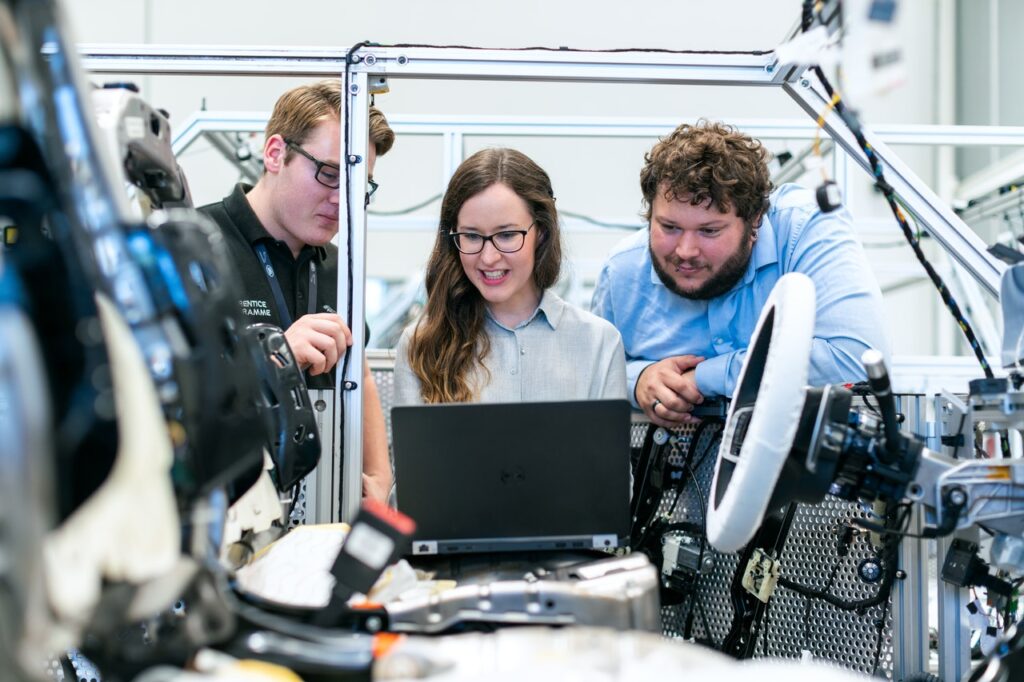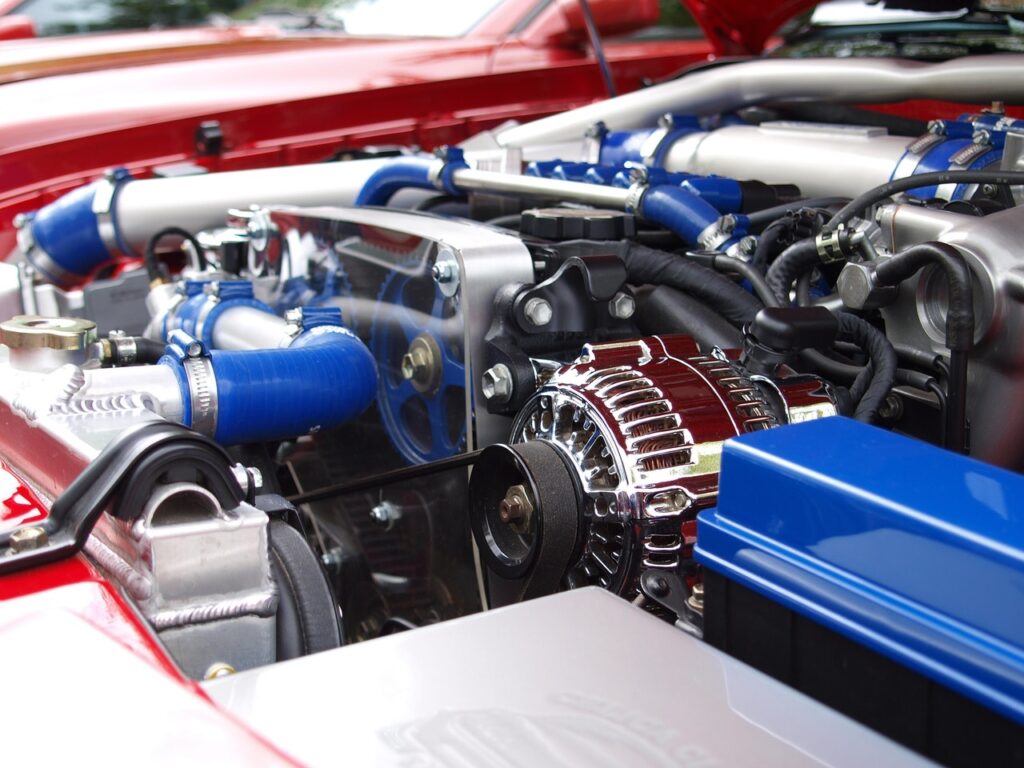What are the differences between mechanical vs automotive engineering is a common question asked by those considering entering the engineering field. While there are many similarities between the two, there are some key aspects of both disciplines that clearly separate them. Read on to see a contrasting look at mechanical vs automotive engineering!
Mechanical Engineering
Mechanical engineering is the branch of engineering that encompasses the study of motion, forces, energy, materials, manufacturing, and design in order to apply them to the creation of mechanical systems and devices that serve society (e.g., engines, refrigerators, machines, tools, etc). The profession serves many diverse fields and industries such as the aerospace, automotive, biomedical engineering, pharmaceutical, and power generation industries, to name just a few. In fact, any device or system that involves movement or energy probably involved one or more mechanical engineers in its creation.
Mechanical engineers use mathematics, computers, sophisticated modeling and analysis to solve problems associated with propulsion, energy usage, power generation, sound and vibration, machinery design, and manufacturing. In short, mechanical engineers play a part in designing and building the mechanical devices and systems that are essential to our everyday lives.
Most entry-level jobs for mechanical engineers require a bachelor’s degree in engineering or mechanical engineering, though some research positions require a master’s degree. Compared to other college graduates, mechanical engineers earn some of the highest starting salaries. Continuing education is critical in this career to keep up with technological advancements.
Automotive Engineering
Automotive engineering, along with aerospace engineering and naval architecture, is a branch of vehicle engineering, incorporating elements of mechanical, electrical, software, electronic, and safety engineering as applied to the design, manufacture and operation of automobiles, motorcycles, trucks and their respective engineering subsystems. It also includes modification of vehicles.

Automotive engineers can design and test engines, brake systems, safety mechanisms, fuel technologies and transmissions. In the field, engineers use design software to devise new vehicle designs or systems, including ThinkDesign Engineering, Gamma Technologies GT-SUITE or Corel Painter Sketch Pad. Some engineers also use grinders, machine tools and workshop presses to fabricate prototype parts for testing. Individuals interested in designing, testing and creating automotive systems may be drawn to this line of work.
A 4-year degree is the minimum qualification for most automotive engineering positions. Undergraduate programs in this field are most commonly offered in automotive engineering technology, which can cover the basic principles of engineering along with modern vehicle design requirements in terms of safety, fuel economy and industrial manufacturing. While master’s degree programs in automotive engineering are available, automotive engineering is a complex and interdisciplinary field, so students may also find relevant coursework through graduate programs in electrical engineering, environmental engineering and mechanical engineering.
Mechanical vs Automotive Engineering Education
Mechanical Engineering
If you’re new to the field, a bachelor’s degree in mechanical engineering is usually suitable to qualify you for an entry-level job. Many schools offer majors specifically in mechanical engineering, though some relevant alternatives include mathematics, chemistry, or physics. If you’re interested in entering management or research positions, then you might need a graduate degree. You can find several master’s and doctoral programs in the same fields, as well as business administration or engineering management.
In a mechanical engineering program, you’ll take classes like system modeling, project finite elements, management, advanced mechanics, machine dynamics, and machine systems design. In many programs, you’ll learn by completing applied research and engineering projects. Graduate programs include extensive research and teaching opportunities, if you’re interested in a career in academia. Additionally, several schools offer fully and partially online degree programs at both the undergraduate and graduate levels.
By law, you’ll need a Professional Engineer (PE) license if you provide public engineering services. The U.S. Bureau of Labor Statistics (BLS) indicated that to obtain this license, you’ll need to graduate from an accredited engineering program, have four years of experience in engineering, and pass the PE examination.
To qualify for full licensure, you must first take the Fundamentals of Engineering (FE) test, which you can take immediately after graduating from an engineering program. After passing this exam, you can begin working as a trainee in the field to gain the work experience required for the PE exam.

Automotive Engineering
An automotive engineer’s career training begins with a four-year bachelor’s degree from an accredited college or university. This is generally the basic requirement for entry-level jobs in the career. While pursuing their bachelor’s degree, students take classes in a range of fields, including physics, mathematics, design and computer science. Certain programs also require core courses in the humanities, in areas such as English or philosophy. The first two years typically consist of foundational classes in math and science, while the last two or three years consist of more engineering-specific courses. Aspiring automotive engineers should pursue a degree in mechanical engineering or a related engineering field.
While students will take general courses covering mechanical engineering, specialized courses may be offered in automotive engineering. These courses may cover automobile dynamics, engine parts, alternative energy sources, fuel cell systems and powertrain dynamics.
An automotive engineering internship will provide students with experience in the field and offers them an opportunity to apply what they have learned in a classroom to professional situations. These internships are offered through automotive suppliers or manufacturers and opportunities may be available to specialize in a specific area. Specializations could be in simulation software, robotics or infrastructure.
After graduating from a bachelor’s in engineering program, engineers in all 50 states must obtain a Fundamentals of Engineering license by passing a rigorous exam. Engineers who complete this step become engineers in training, or EITs, or engineer interns, also known as EIs. EITs become eligible to take the Principles and Practice of Engineering exam after they’ve fulfilled the state requirement for work experience, which in most states is four years. Individuals who pass this exam receive a professional engineer, or PE, license for the state in which they reside.
Mechanical vs Automotive Engineering Careers
Mechanical Engineering
Some mechanical engineers play an integral part in every part of the engineering process, whilst others will specialise in one specific area such as installation and maintenance or CAD design. As mechanical engineers progress into more senior roles, they may have wider business-focused responsibilities, such as budget control and managing other engineers on specific projects to ensure that everything is done quickly and efficiently.
The Bureau of Labor Statistics (BLS) projects that employment opportunities for mechanical engineers will increase by 9% from 2016 to 2026, slightly faster than the average rate of growth for the rest of the economy. Certain related fields, however, should experience significantly faster expansion. For example, the BLS projects that demand for petroleum engineers will grow by 15% during the same time period.
In addition to strong job prospects, mechanical engineering careers also offer exceptional earning potential. In 2018, mechanical engineers earned a median salary of $87,370, more than double the median pay for all other occupations. Architectural and engineering managers earned a median salary of nearly $141,000 that same year. While you can qualify for most of these lucrative positions with a bachelor’s degree, some senior-level roles may require a master’s degree.
Automotive Engineering
Like most fields, there isn’t just one career path for an automotive engineer. Many people in the field work for vehicle manufacturers, but other options could include tire manufacturers, research facilities, and even privately-owned or specialist vehicle design businesses.
Some automotive engineers may go into marketing and sales to help find automobile leads and study the market, or they could end up working for themselves and doing contract work. While automotive engineers can be generalists and work on every aspect of vehicle design and manufacturing, a few specific paths include research and development, vehicle design, part testing, manufacturing, maintenance, and sales.

Someone may start out in project engineering or management and move towards business planning. The career paths are truly endless in this field, which is a big part of what makes automotive engineering so appealing to people of all ages and skill levels.
Additionally, this is an industry that is changing its prerequisites. With all of the different technologies today, like artificial intelligence and virtual reality, people from non-engineering backgrounds are finding jobs in the automotive engineering industry.
Mechanical vs Automotive Engineering Job Description
Mechanical Engineer
Mechanical engineers design power-producing machines, such as electric generators, internal combustion engines, and steam and gas turbines, as well as power-using machines, such as refrigeration and air-conditioning systems.
Mechanical engineers design other machines inside buildings, such as elevators and escalators. They also design material-handling systems, such as conveyor systems and automated transfer stations.
Like other engineers, mechanical engineers use computers extensively. Mechanical engineers are routinely responsible for the integration of sensors, controllers, and machinery. Computer technology helps mechanical engineers create and analyze designs, run simulations and test how a machine is likely to work, interact with connected systems, and generate specifications for parts.
Some job responsibilities of a mechanical engineer include:
- Analyze the test results and change the design or system as needed
- Analyze problems to see how mechanical and thermal devices might help solve a particular problem
- Design or redesign mechanical and thermal devices or subsystems, using analysis and computer-aided design
- Develop and test prototypes of devices they design
- Investigate equipment failures or difficulties to diagnose faulty operation and to recommend remedies
- Oversee the manufacturing process for the device
Automotive Engineer
Automotive engineers are involved in the design, manufacture, distribution, marketing, sales and after-sales care of cars (including racing cars), motorbikes and other commercial vehicles. Engineers will work on the aesthetics and technical performance of these vehicles and, increasingly, the electronics and software involved with modern vehicles.

Some job responsibilities of an automotive engineer include:
- Analyzing, interpreting and condensing technical data into reports or presentations
- Analyzing energy, environmental and safety aspects of the planned project
- Developing testing procedures
- Investigating product failures
- Preparing cost estimates and design specifications
- Preparing plans and drawings
- Predicting vehicle or component behavior under different conditions using computerized models
- Researching, designing, developing and producing vehicles and components
If you have anything to add, please feel free to leave a comment down below, and sign up to our newsletter for more of the same content!




I like your work and your country to, please can I get employment in your company or your home town